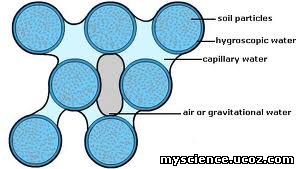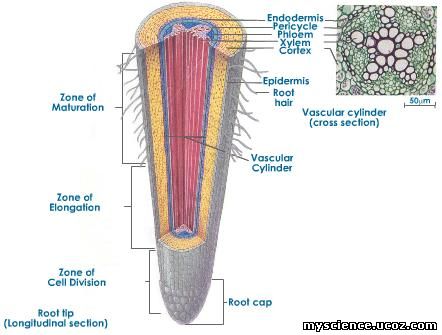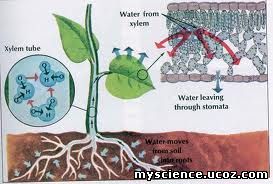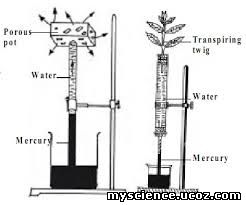Absorption of Water The internal structure of the plant body is considered to carry out the mechanism of gaseous exchange. As a result plants absorb water through transpiration to meet the water deficiency. Plants absorb water from the soil by their roots. The movement of water takes place by: · Active transport: Requires metabolic energy. · Passive transport: Does not require metabolic energy. Ø Sources of Water The principle source of soil water is the rain. Following are the different types of water which can or cannot use by the plants. · Run-away water The water of this drains away along the slopes after a heavy rainfall or irrigation and not available to the plants. · Gravitational water The water of this percolates downwards through the large pores between the soils particles under the influence of gravity and reaches the water table or ground water and is not available to the plants. 
· Hygroscopic water The water of this forms a thin layer or film on the soil particles due to the surface forces (adsorption) and is an available to the plants. · Capillary water The water of this forms a film around the soil particles and is available to the plants. The soil colloids are of great significance as water fills into spaces between the non-colloidal particles. Mechanism of Water Absorption Water is highly essential for plants for various metabolic activities. They get their water from soil. The way in which the water from the soil enters the roots known as mechanism of water absorption takes place by two routes as follows: Ø Active Absorption The absorption of water by roots with the utilization of metabolic energy which is generated by the root respiration known as active absorption. The force of water absorption originates due to the root respiration hence the root cells actively participate. Based on this absorption, two theories have bveen proposed as follows: · Active Osmotic Water absorption(By Atkins & Priestley) According to this theory water moves up from the soil to roots along an increasing gradient of Diffusion Pressure Defict (DPD), It the solute concentration is high water potential will be low in root cells hence water can enter from soil to roots through endosmosis. · Active Non-Osmostic Water absorption(By Thimann & Kramer According to this theory water absorbed against concentration gradient. There is no direct evidence for this but some scientists suggested that the involvement of energy from respiration. In conclusion the evidences supports active absorption of water is they poor. 
Structure of root involved in absorption of water Ø Passive absorption `The absorption of water by roots without the utilization of metabolic energy known as passive absorption. In this only root act as an organ of absorption hence it also called as water absorption through roots. It occurs rapidly in transpiring plants during day time because of opening of stomata and atmosphere condition .The force for absorption is created at the leaf end i.e., transpiration pull which helps to suck the water from xylem. Transpiration Pull
It
is responsible for dragging water at the leaf end; the force is transmitted
down to the xylem through water column in the xylem elements. The continuity of water column remains intact due
to the cohesion between the molecules and it acts as a rope.
As
transpiration proceeds
simultaneously water absorption also
takes place to compensate the water loss from the leaf end. Most volume of
water entering plants is by means of passive
absorption.
Ø
Movement
of Water through the Cell
The movement of
water takes place in two routes as follows:
·
Symplastic
movement
The movement of
water and solutes takes place through the continuos connection of cytoplasm, no crossing of plasma membrane. ![]() 
·
Apoplastic
movement
The movement of
water and solutes takes place through the cell
walls and intercellular spaces,
no crossing of plasma membrane.
Ascent of Sap
The upward
movement of water against gravitational force from the root to the shoot known
as Ascent of Sap.
Ø
Pathway
The water
absorbed by the root hairs moves upwards via root tissues (cortex, passage
cells of endodermis, pericycle) and finally reaches to the xylem.
After entrance,
it starts its upward movement until it reaches the mesophyll cells and finally
evaporates through stomata. Only a small amount of water is utilized by plants
for metabolism rest is lost in transpiration.
Ø
Mechanism
Various theories have been proposed to explain the mechanisms of this are
as follows:
·
Vital
theories
According to this theory, living cells are required for ascent of sap.
These have been proposed by the chief advocators namely Godlewski (Relay Pump theory), Bose
(Pulsation theory) and Molish.
These theories were discarded because it was discovered that some poisons
can also be translocated. Thus fundamental
basic of these theories failed.
Poisons: Picric acid, Carbolic acid.
·
Root
Pressure theory
In 1956, Stocking defined root
pressure as "the pressure developing in tracheary elements of xylem as a result
of metabolic activities of roots”.
The xylem of root is completely filled with water hence a +ve hydrostatic pressure develops within the roots due to accumulation of absorbed
water known as root pressure.
Ø
Experiment
·
Aim:
To know the pressure developing in the root.
·
Apparatus:
potted plant, glass tube, rubber tube. Manometer
·
Procedure
ü Take
a potted plant and cut the stem.
ü Then
take a glass tube filled with water and attach this to the root with the help
of rubber tube. 
·
Observation:
After sometime water level raises in the tube(for easy observation add a
drop of colour to the water)
·
Result:
The pressure created by the leaf from the root
·
Note : Root pressure can push water upwards by
not more than a few meters can be observed in many plants but it is not
adequate to push water to greater heights(125m)
·
Objections
ü It
has not been observed in conifers,
ü It
is generally low during summer in temperature regions when the rate of transpiration
is high.
ü Ascent
of sap continuos even in the absence of root pressure.
·
Note:
Root pressure is a force for ascenrt of sap in herbs and shrybs but not in
trees.
·
Physical
theories
The theories which consider the dead cells of xylem top be responsible
for ascent of sap known as physical theories.
Some of the theories are Biochem’s
Capillary theory, Jamin’s Chain
theory, Sach’s imbibitions theory
and cohesion tension theory which is
widely accepted.
Ø
Cohesion
tension/Transpiration pull theory(Dixon & Jolly I n1894)
This theory is
based on the following features like
·
Cohesion and adhesion of water molecules.
·
Continuity of water column.
According to the theory, evaporation of water from the cells of the leaf
is responsible for raising water from the root. As a result water potential
reduces in the cells next to the xylem.
Therefore water enters these cells from the xylem sap which has higher water potential directed towards the
cell walls of xylem vessels.
The xylem
vessels are full of water and this water leaves hence an upward tension is
created in the water column. Due to these upward tension i.e., transpiration pull water ascends up
with a n unbroken water column. 
The cohesive
forces of attraction between the water molecules and adhesive forces between
the water molecules and walls of xylem vessels. Due to the transpiration pull
an upward movement of water from roots to the leaves is created in accordance
with water potential gradient.
ü Cohesion: Water molecules have a strong
mutual attraction which tends to stick together.
ü Adhesion: Water molecules tend to stick
to the wall of the xylem elements.
Ø
Experiment
·
Aim: To
know the water moving from root to stem.
·
Apparatus:
Beaker, glass tube, wet sponge.
·
Procedure
ü Take
a beaker with full of water.
ü Then
take a glass tube with water and immerse into the beaker.
ü Finally
take a wet sponge and fit it to the tube.
·
Observation
ü
Water evaporates from sponge.
ü
Sponge obsorbs water from the glasss tube.
ü
Glass tube takes water fro mthe beaker.
·
Result:
Water pulled up from the beaker by the sponge.
·
Note:
Sponge: Leaf, Glass tube: Stem, Beaker: Root & Soil. 
·
Objections
ü Formation
of gas bubbles in the xylem hence there will be obstruction to the water column
continuity known as embolism.
ü Tracheids
are more efficient because their septa grant stability to the ascending column
of water .The gradual elimination of tracheids by vessels in the course of
evolution does not support this continuation.
·
Evidences
ü Osmotic
potential of 10 – 20 bars develops in the cells of leaves hence the tension can
raise water up to a height of 330 – 600feet.
ü Cohesive
force between the water molecules is 30
– 200 atm. pressure, this force is
sufficient to prevent the breakage of water column.
| 




